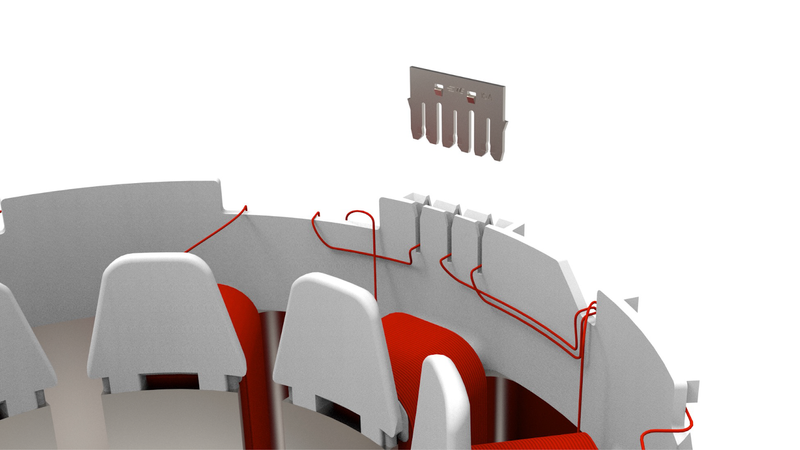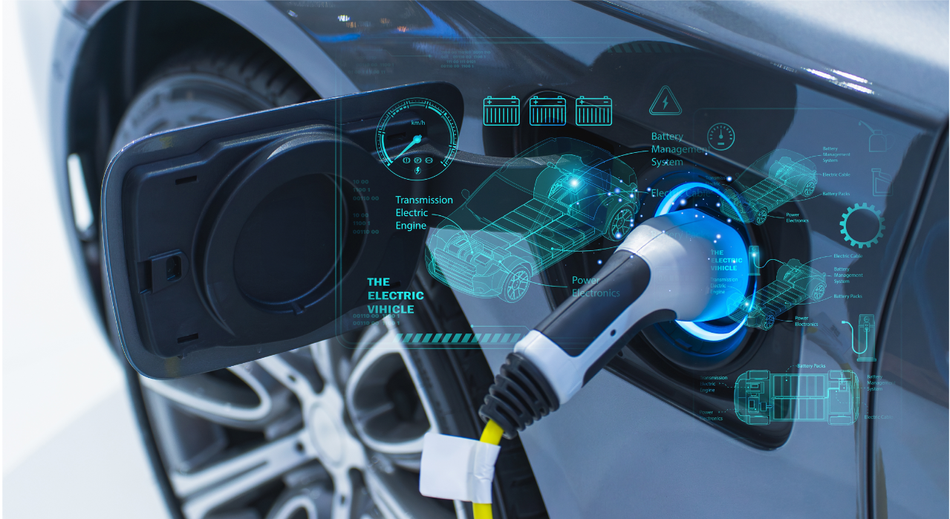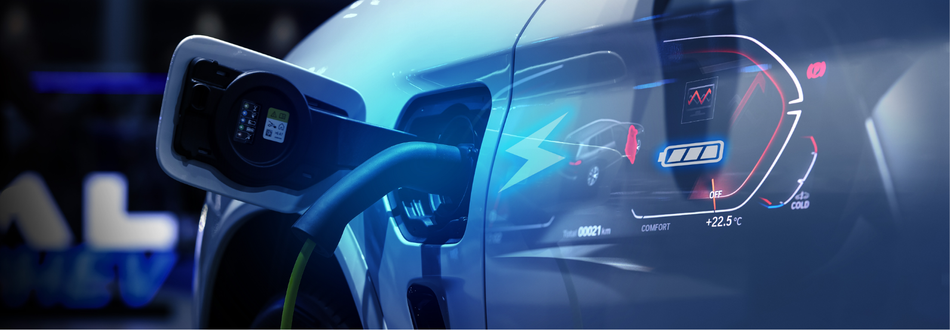Solderless Magnet Wire Solutions For Electric Vehicle Air Conditioner Compressors And Electronic Parking Brake Motors
Read Article #2 of 2 in the Solderless Magnet Wire Solutions Mini-Series.
This is article #2 of 2 in the Solderless Magnet Wire Solutions Mini-Series: Solderless solutions enhance the assembly of key EV systems, such as air conditioning compressors and electronic parking brakes, by improving reliability, reducing complexity, and streamlining manufacturing processes.
Read article #1 on Solderless Magnet Wire Solutions for Electric Vehicle Applications.
Introduction
In the rapidly evolving field of electric vehicles (EVs), the pursuit of enhanced efficiency and reliability drives innovation at every level. Among these innovations, solderless magnet wire solutions are revolutionizing the motor assembly of critical vehicle systems such as air conditioning (AC) compressors and electronic parking brakes (EPB).
Solderless magnet wire solutions employ advanced techniques like crimping and insulation displacement to create robust and efficient electrical connections without traditional soldering. By implementing these technologies, TE Connectivity (TE) significantly improves the functionality and performance of EV AC compressor motors and EPB systems.
This is the second and concluding article in our two-part mini-series on Solderless Magnet Wire Solutions. Following the discussion on the limitations of traditional soldering methods, this second piece delves into the practical applications of TE Connectivity’s solderless technologies in EVs. Here, we explore detailed case studies of AC compressors and EPB motors, illustrating these innovative solutions’ real-world advantages and transformative potential in enhancing EV component performance and manufacturing efficiency.
Leading Innovation in EV Motors with Solderless Magnet Wire Solutions
TE Connectivity’s work on solderless magnet wire solutions is part of a broader effort to improve the sustainability and efficiency of electric vehicles. By simplifying the manufacturing process and improving product performance, these solutions contribute to the development of more reliable and environmentally conscious technologies in the EV industry.
Advantages of Solderless Solutions
Solderless solutions offer vital benefits that address the limitations of traditional soldering methods in the manufacturing of motors. Some key benefits include:
Cost-Effectiveness
Manufacturers can significantly reduce labor costs and increase production throughput by implementing solderless connections. These solutions eliminate the need for traditional soldering steps such as insulation stripping and flux application, which speeds up the manufacturing process and reduces the potential for human error.
Reliability
Solderless connections provide a consistently high level of quality. With precisely controlled mechanical processes, these connections minimize the risk of defects arising from manual soldering techniques, such as cold joints or overheated connections, ensuring superior long-term performance of EV components.
Flexibility
TE Connectivity’s solderless technologies are capable of connecting a wide range of wire gauges and types, including copper and aluminum magnet wires. This flexibility allows for their use in various applications within the EV, from small sensors to large powertrain components.
Environmentally Friendly
Solderless solutions contribute to a cleaner manufacturing process by eliminating the need for chemicals and reducing the energy typically required for soldering. This helps manufacturers comply with increasingly stringent environmental regulations and supports broader sustainability goals within the industry.
This commitment to innovation and the clear advantages of solderless technologies drive improvements in the manufacturing of EV subsystems utilizing motors and pave the way for broader applications in other industries seeking reliable and efficient electrical connections.
The following case studies illustrate how solderless magnet wire solutions by TE Connectivity enhance functionality and streamline production in EV AC compressors and EPB motors.
Case Study 1: EV Air Conditioning Compressor Motor
In EVs, the AC system plays a crucial role in enhancing passenger comfort and ensuring vehicle efficiency and effective battery management. Unlike conventional vehicles that power the AC system using the engine, the compressor is powered directly by the vehicle’s battery in EVs. This setup places a premium on the efficiency of the compressor since its power consumption directly impacts the vehicle’s range. The efficiency of the compressor is integral as it is also part of the thermal management system that helps regulate the temperature of the battery, which is crucial for maintaining optimal battery health and performance.
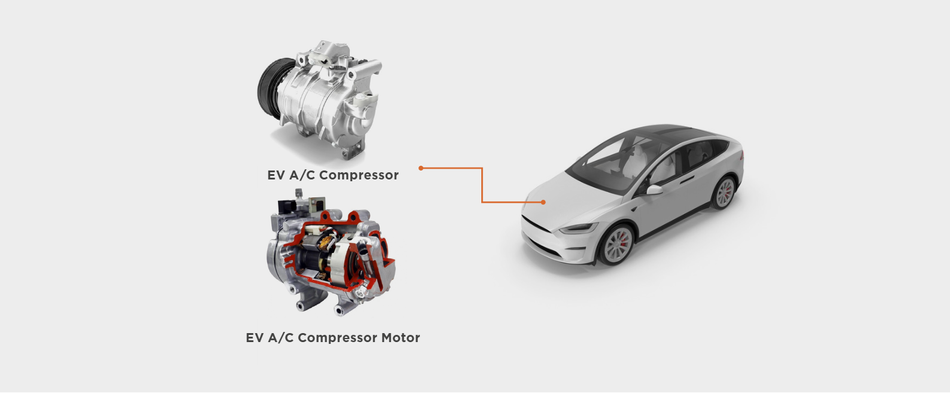
The AC compressor operates as the central pump of the air conditioning system, circulating refrigerant through the system. It compresses the refrigerant, which absorbs heat from the car’s interior and expels it outdoors. In electric vehicles, this compressor is typically driven by an electric motor that must be reliable and capable of operating efficiently under varying loads and environmental conditions. This compressor’s effectiveness directly influences the vehicle’s overall energy consumption. A more efficient compressor contributes to reduced energy usage, significantly extending the vehicle’s range per charge.
Integrating such an efficient compressor motor into an EV involves overcoming several challenges, including space constraints and the need for robust electrical connections that can withstand the rigors of vehicle operations, such as vibrations and temperature fluctuations. The electrical connections for the motor must be particularly durable and secure to ensure consistent performance, as any failures can lead to a non-operational AC system, directly affecting driver comfort and safety.
Internal Connection Solution
TE Connectivity has developed solderless solutions specifically designed for these motors. These solutions use magnet wire terminals with insulation displacement contact (IDC) technology to integrate directly with magnet wire, without soldering. The terminals are then connected to cluster block connectors that link to the pass-through connector pins.

For example, TE Connectivity AMPLIVAR terminals, which were introduced to streamline the connection process, utilize a serrated barrel design that mechanically pierces and displaces the wire insulation, creating a secure and reliable metal-to-metal contact without the need for pre-stripping the wire. This connection method speeds up the assembly process and reduces potential damage to the wire, enhancing the motor’s reliability and longevity.
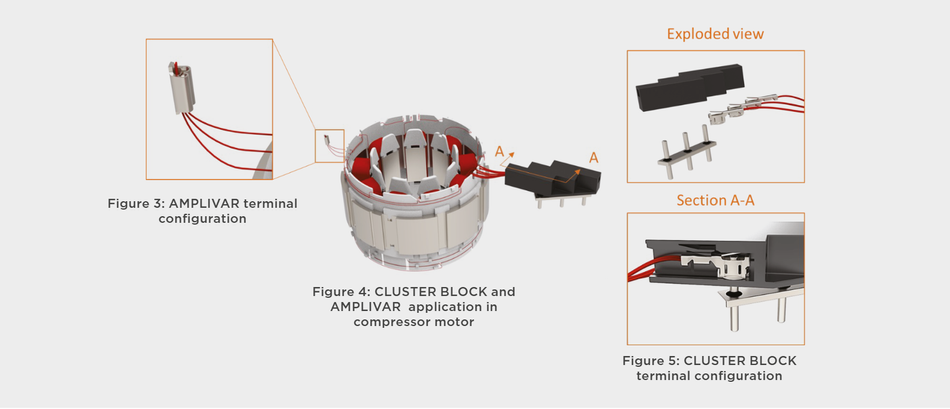
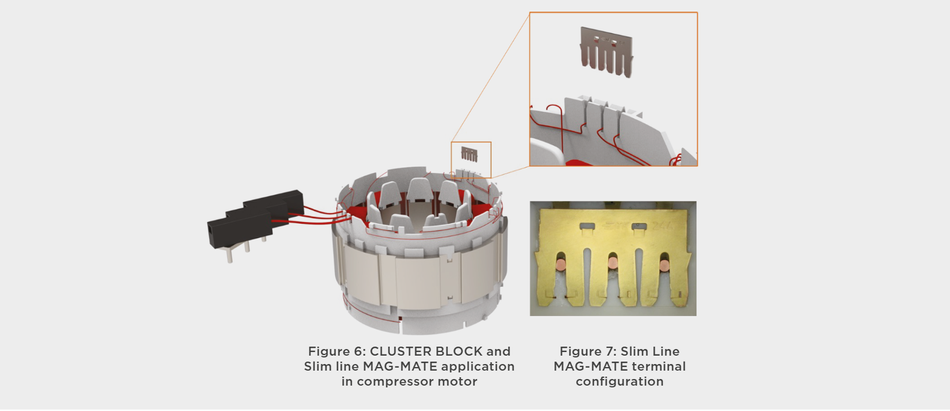
External Connection Solution
Externally, the connection of the compressor motor to the vehicle’s power system is equally crucial. TE Connectivity offers customized solutions that incorporate printed circuit board assembly (PCBA) integration with the external housing of the compressor. This approach ensures a hermetic seal that protects the internal components from environmental factors such as moisture and dust while providing a stable electrical connection that withstands vibrations and thermal expansion.
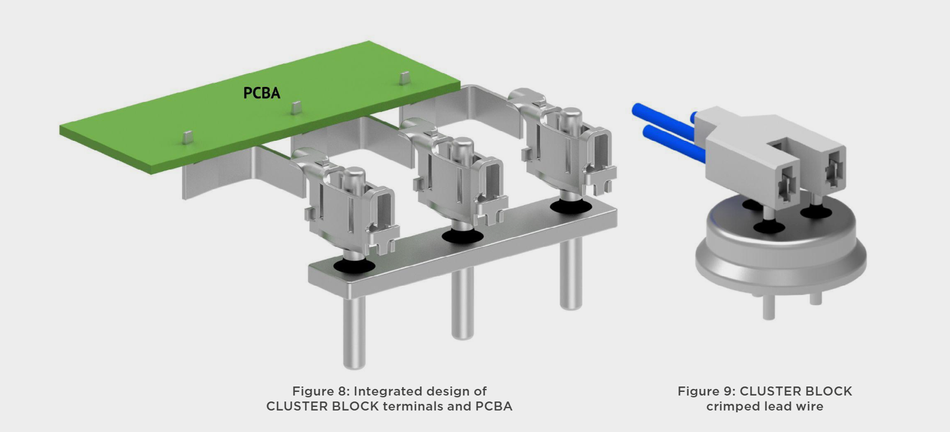
Benefits in Applications
Enhanced Durability: The connections are more resistant to environmental stresses, ensuring longer operational life for the compressors.
Improved Efficiency: Reduced electrical resistance at connection points increases the overall efficiency of the AC system.
Simplified Manufacturing: Eliminating soldering from the manufacturing process reduces complexity and allows for more streamlined production lines.
Case Study 2: EV Electronic Parking Brake Motors
EPBs are a significant advancement in automotive technology, especially crucial in EVs, where efficiency and safety are paramount. EPBs replace traditional mechanical handbrakes, enhancing vehicle functionality by offering a safer, more reliable, and space-saving braking system. This shift towards automation and precision in vehicle control systems introduces EPBs as a system that operates at the touch of a button, providing ease of use and contributing to more ergonomic interior designs, a common feature in EVs prioritizing minimalist functionality.
EPBs function using actuators controlled electronically rather than the traditional cable systems of mechanical brakes. When activated, these actuators exert force on the brake calipers, effectively locking the wheels. Integrated seamlessly with the vehicle’s electronic control unit (ECU), EPB processes signals to automatically engage or disengage the brakes based on driver inputs or specific conditions such as inclines, enhancing vehicle responsiveness and safety. This rapid activation capability is essential in emergencies or when maintaining stationary positions on slopes, ensuring enhanced operational safety.
Integrating EPBs into EVs involves overcoming several challenges, including ensuring precise control and integration with the vehicle’s broader safety systems. The actuators and their connections must be highly reliable, as any malfunction could compromise safety. Additionally, the design must maintain consistent performance across varying temperatures and driving conditions, circumventing the physical wear and frequent adjustments required by mechanical systems. By improving safety and contributing to a more refined driving experience, EPBs exemplify the movement towards more automated vehicle systems, aiming to increase safety, efficiency, and comfort for drivers and passengers alike.
Integrated Design Solution
TE Connectivity has embraced the challenge of improving these systems through advanced solderless magnet wire solutions. Utilizing SIAMEZE terminals, TE Connectivity has engineered an integrated design that connects magnet wires directly to the electronic control unit’s PCBA. This solution involves minimal components and allows for a streamlined assembly process. Using SIAMEZE terminals helps ensure a stable, gas-tight connection that enhances the reliability and performance of the parking brake system.
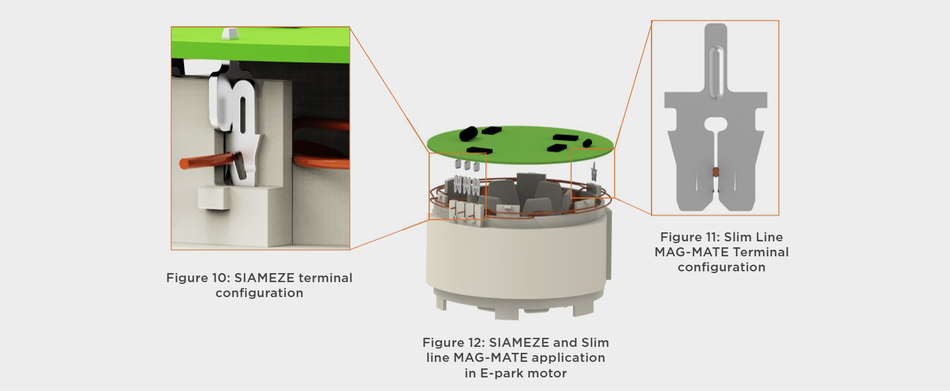
Image Source: TE Connectivity
Benefits in Applications
High Reliability: The solderless connections reduce the likelihood of mechanical failure due to vibration or thermal expansion, critical in safety-related components like parking brakes.
Compact Design: The reduced space requirement of the solderless connections allows for more compact motor designs, essential in the constrained spaces typical of modern vehicle architectures.
Automated Operation: With the connections being highly reliable and easy to automate, the overall manufacturing process is simplified, enhancing scalability and reducing the cost of production.
Application Tooling
TE Connectivity has developed a sophisticated line of magnet wire termination machines specifically designed to optimize the use of AMPLIVAR and MAG-MATE terminals. These tools are engineered to enhance the efficiency and reliability of magnet wire terminations in electric vehicle applications. Features include:
Precision Adjustment Capabilities: Many of TE’s machines are equipped with automatic precision adjustment features, ensuring consistent and precise terminations every time. This capability is crucial for maintaining high-quality standards in production, especially when dealing with delicate magnet wires.
Wide Range of Configurations: The tools are available in various configurations to accommodate a broad spectrum of magnet wire termination needs. Whether for large-scale production or specialized custom applications, TE Connectivity provides solutions that can address the diverse demands of the industry.
High Reliability with Minimal Wire Preparation: These machines allow for high reliability in connections with minimal preparatory work on the wires themselves, significantly reducing the potential for human error and increasing the overall throughput of the production process.
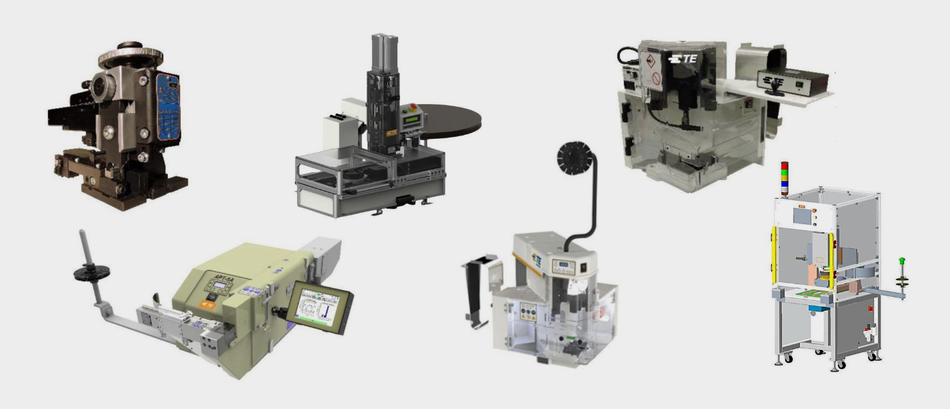
The introduction of these tools into the manufacturing process translates to not only faster production times but also lower costs and reduced waste. The precision and automation provided by these tools help ensure that each connection is optimized for performance and durability, further enhancing the overall quality of the electric vehicle components.
Conclusion
Through this series, we explored how TE Connectivity’s solderless magnet wire solutions are transforming motor manufacturing process in the EV industry. From enhancing the efficiency of AC compressor motors to improving the reliability of EPB systems, these innovative technologies demonstrate significant advantages over traditional soldering and welding methods.
The adoption of solderless solutions is set to expand, driven by the growing demands for higher efficiency, reduced manufacturing complexity, and enhanced sustainability within the EV sector. As these technologies continue to evolve, their application is all set to extend beyond the automotive industry into other areas requiring reliable, high-performance electrical connections.
Visit www.te.com/support to chat with a Product Information Specialist.
TE, TE Connectivity, AMPLIVAR, MAG-MATE, SIAMEZE and TE connectivity (logo) are trademarks owned or licensed by the TE Connectivity plc family of companies. Other product names, logos, and company names mentioned herein may be trademarks of their respective owners. The information given herein, including drawings, illustrations and schematics which are intended for illustration purposes only, is believed to be reliable. However, TE Connectivity makes no warranties as to its accuracy or completeness and disclaims any liability in connection with its use. TE Connectivity‘s obligations shall only be as set forth in TE Connectivity‘s Standard Terms and Conditions of Sale for this product and in no case will TE Connectivity be liable for any incidental, indirect or consequential damages arising out of the sale, resale, use or misuse of the product. Users of TE Connectivity products should make their own evaluation to determine the suitability of each such product for the specific application. TE reserves the right to make any adjustments to the information contained herein at any time without notice. TE expressly disclaims all implied warranties regarding the information contained herein, including, but not limited to, any implied warranties of merchantability or fitness for a particular purpose. © 2025 TE Connectivity. All Rights Reserved.” |
